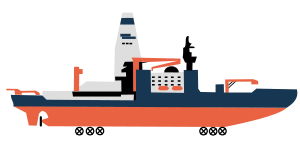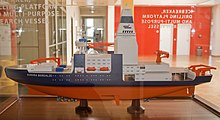Aurora Borealis (icebreaker)
 rough sketch of ERI Aurora Borealis
| |
| History | |
|---|---|
| Name | Aurora Borealis |
| Namesake | Aurora Borealis |
| Operator | European Science Foundation |
| Cost |
|
| General characteristics (initial concept)[1] | |
| Type | Icebreaker |
| Displacement | 65,000 tons |
| Length | 199.85 m (655.7 ft) |
| Beam |
|
| Draught | 13 m (43 ft) |
| Ice class | Polar Class 1 |
| Installed power | Eight main generators, 94 MW |
| Propulsion |
|
| Speed |
|
| Endurance | 90 days |
| Crew | Accommodations for 120 personnel (science and crew) |
| Aviation facilities | 2 helipads, hangar for 3 helicopters |
Aurora Borealis is a proposed European research icebreaker, comparable to the world's strongest icebreakers,[2] planned jointly by a consortium of fifteen participant organizations and companies[3] from ten European nations. If built, she would be the largest icebreaker ever built as well as the first icebreaker built to the highest IACS ice class, Polar Class 1.
The unique feature of the proposed vessel is its ability to perform scientific deep sea drilling in a sea ice covered ocean. The ship is proposed to have an operational lifetime of 35 to 40 years, with the main area of operations being the inner Arctic Ocean.
History and background[edit]

The planning for the vessel started in 2002. The project is coordinated by the European Polar Board, an expert board of the European Science Foundation.[4]
In March 2007 the BMBF (the German Federal Ministry for Science and Education) funded the preparations for Aurora Borealis, the Helmholtz Association center Alfred Wegener Institute for Polar and Marine Research hosted this project.
In 2010, the German Council of Science and Humanities stopped to support the planning which made the future of the 800-million-euro ship, designed by Schiffko[2] (nowadays Wärtsilä Ship Design[5]), uncertain. The project has been delayed, and a slightly smaller and cheaper (less than 500-million-euro) version, Aurora Slim, has been suggested by the Finnish engineering company Aker Arctic.[5]
Aurora Slim[edit]
The most prominent change from Aurora Borealis to Aurora Slim is that the insulated drilling rig is no longer present. The scientist have to rely on a mobile system and shallower boreholes of a few hundred metres instead of more than 1,000 metres (3,300 ft). She will also have only a single moon pool instead of two as in the original concept.[6]
Like the original concept, the vessel is designed to break level ice up to 2.5 metres (8.2 ft) in thickness. However, the dynamical positioning system of the smaller vessel consists of three 15 MW azimuth thrusters and two 3.5 MW bow thrusters instead of three fixed propeller shafts with 27 MW propulsion motors and six 4.5 MW retractable transverse thrusters. The number and output of generating sets has also been reduced.[6]
Participants[edit]
The participants in the Aurora Borealis project are listed in the following table.[7]
References[edit]
- ^ Technical details Archived April 25, 2012, at the Wayback Machine. European Research Icebreaker AURORA BOREALIS. Retrieved 2011-12-23.
- ^ a b Data Sheet for Overview Archived October 30, 2012, at the Wayback Machine. Retrieved 2012-10-09.
- ^ "Aurora Borealis: European Research Icebreaker". European Science Foundation. Archived from the original on April 16, 2009. Retrieved 2009-05-25.
- ^ "Focus on Aurora Borealis". European Science Foundation. 2010-08-24. Archived from the original on 2011-09-27. Retrieved 2011-10-15.
The European Science Foundation has a major role in the development effort for such a research vessel. The European Polar Board (EPB), an ESF expert committee, coordinates the EC's FP7 project 'European Research Icebreaker Consortium - AURORA BOREALIS' (ERICON-AB) that is preparing a strategic, legal and organisational framework for construction and operation of AURORA BOREALIS.
- ^ a b Finnish ship designers blaze trail to Arctic maritime routes. Helsingin Sanomat, 8 January 2012. Retrieved 2012-02-27.
- ^ a b ERICON-AB Aurora Slim Archived August 11, 2014, at the Wayback Machine. Mikko Niini, 1 March 2012. Retrieved 2012-09-07.
- ^ "Participants of the ERICON project". European Science Foundation. 2009-01-23. Archived from the original on 2011-09-22. Retrieved 2009-07-10.
